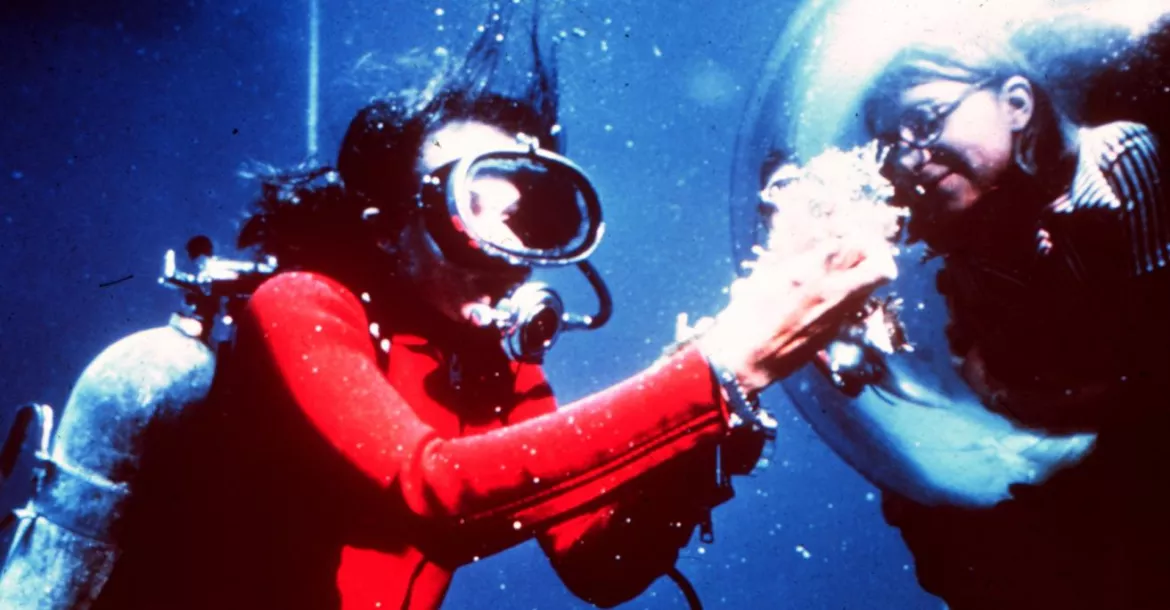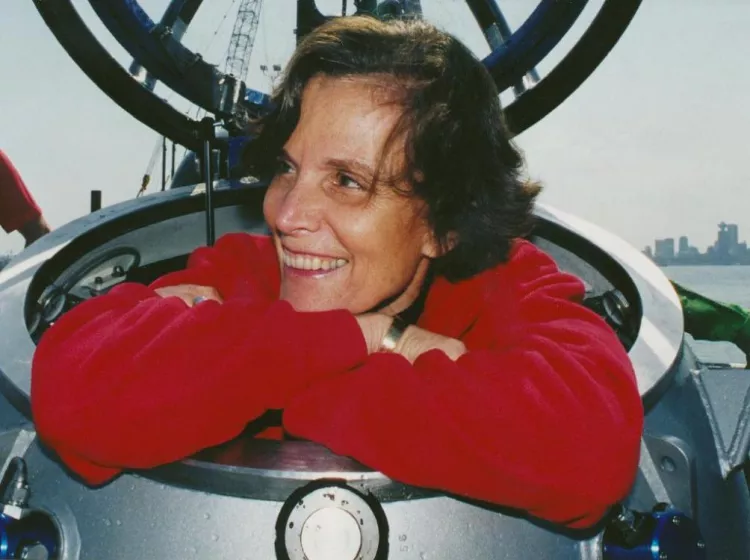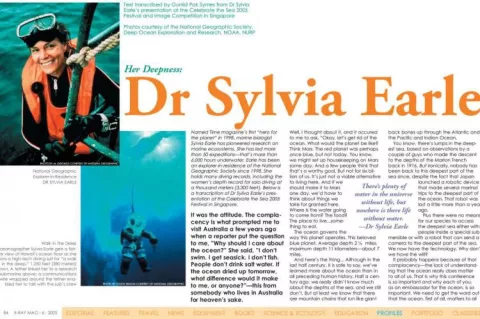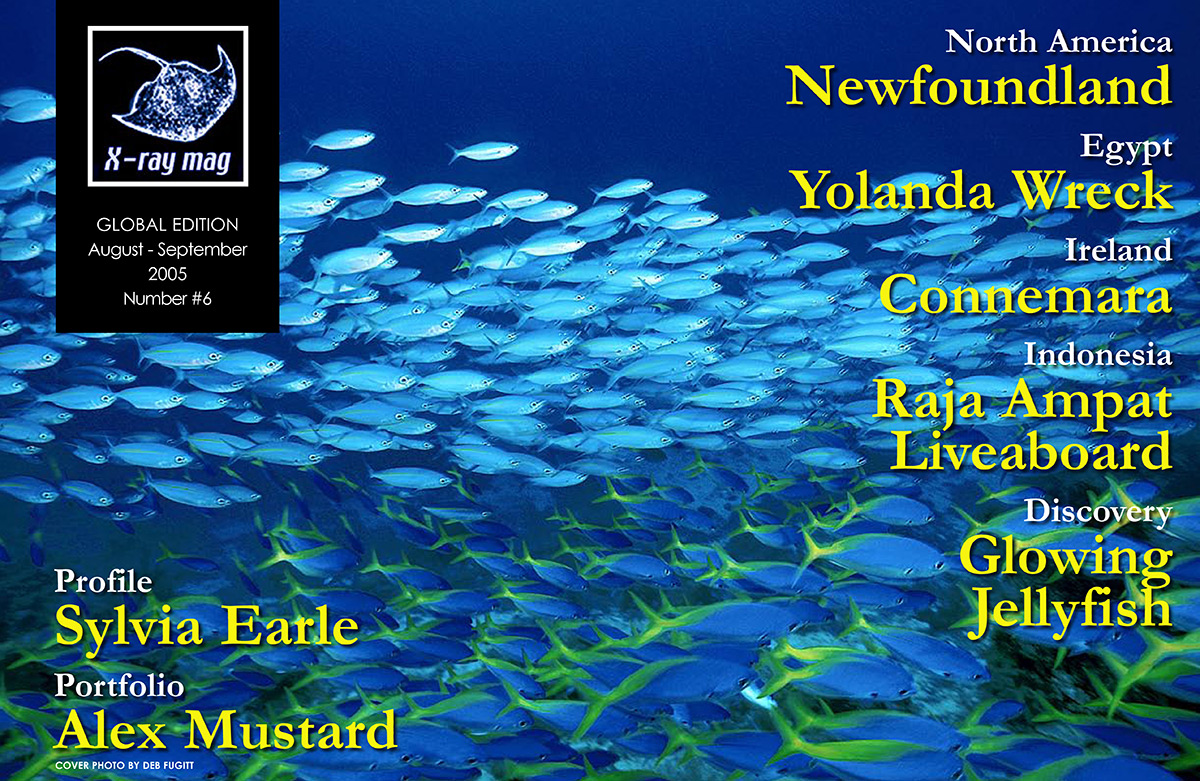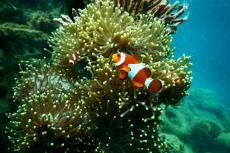Named Time magazine’s first “hero for the planet” in 1998, marine biologist Sylvia Earle has pioneered research on marine ecosystems. She has led more than 50 expeditions—that’s more than 6,000 hours underwater. Earle has been an explorer-in-residence at the National Geographic Society since 1998. She holds many diving records, including the women’s depth record for solo diving at a thousand meters (3,300 feet).
It was the attitude. The complacency is what prompted me to visit Australia a few years ago when a reporter put the question to me, ”Why should I care about the ocean?” She said, ”I don’t swim. I get seasick. I don’t fish. People don’t drink salt water. If the ocean dried up tomorrow, what difference would it make to me, or anyone?”—this from somebody who lives in Australia for heaven’s sake.
Well, I thought about it, and it occured to me to ask, “Okay, let’s get rid of the ocean. What would the planet be like? Think Mars. The red planet was perhaps once blue, but not today. You know, we might set up housekeeping on Mars some day. And a few people think that that’s a worthy goal. But not for six billion of us. It’s just not a viable alternative to living here.
And if we should make it to Mars one day, we’d have to think about things we take for granted here. Where is the water going to come from? The food? The place to live...something to eat.
The ocean governs the way this planet operates. This beloved blue planet. Average depth 2 ½ miles, maximum depth 11 kilometers—about 7 miles.
And here’s the thing... Although in the last half century, it is safe to say, we’ve learned more about the ocean than in all preceding human history. Half a century ago, we really didn’t know much about the depths of the sea, and we still don’t. But at least we know that there are mountain chains that run like giant back bones up through the Atlantic and the Pacific and Indian Ocean.
You know, there’s lumps in the deepest sea, based on observations by a couple of guys who made the descent to the depths of the Marion Trench back in 1916. But ironically, nobody has been back to this deepest part of the sea since, despite the fact that Japan launched a robotic device that made several marinal trips to the deepest part of the ocean. That robot was lost a little more than a year ago.
Plus there were no means for our species to access the deepest sea either with people inside a special submersible or with a robot that can send a camera to the deepest part of the sea. We now have the technology. Why don’t we have the will?
It probably happens because of that complacency—the lack of understanding that the ocean really does matter to all of us. That is why this conference is so important and why each of you, as an embassador for the ocean, is so important. We need to get the word out that the ocean, first of all, matters to all humankind. Without the ocean, there would be no life on Earth—certainly not life as we know it. And it may be like on Mars where there was apparently an ocean once upon a time or maybe like on one of the moons of Jupiter—Europa.
In fact, whereever there is water in the universe, there is a possibility that there might be life, because water is the cornerstone of what makes life possible—the single non-negotiable thing. There can be water without life, but not life without water. So, at the same time as we have learned more about the nature of the sea, it’s possible that we have lost more owing to what we are putting into the sea and what we are taking out of the ocean.
I was asked a few years ago by a group of individuals who were concerned about the complacency concerning the oceans, “How do we change the way people think? How do we get inside their heads and do something about the problems that are taking place?”
After all, in the last half century, we’ve probably lost on the order of 90 percent of the big fish in the sea based on a study that was done by Canadian scientists just recently that documents that tuna, swordfish, cod—fish that ran in the deep seas—grouper, snapper, big halibut...The big fish have been extracted from the oceans. The sharks. That has happened in my lifetime, it’s happened in the lifetime of many of you. The pace right now is picking up, which is what makes this point in history so important.
So, given the chance to hopefully guide this interest in doing something to convey to people—not just the scientists, not just the divers, not just those who are curious about the ocean, but the public at large—we dreamed up the concept of doing a film with the National Geographic Society about a fish.
It took some doing to sell the National Geographic Society on the idea of doing a film about fish. Now, a film about lions... we got lots of films about lions; tigers... lots of films about tigers; sharks...there have been a number of films about sharks. But in this case, we convinced the National Geographic Society to choose one of the other big predators in the sea. And I just want to share with you the opening sequence from this film. It runs a full hour, and I only have a few minutes to stand here in front of you and show you some of these images. But let me start with this one. (The following is the script of the film clip) ...
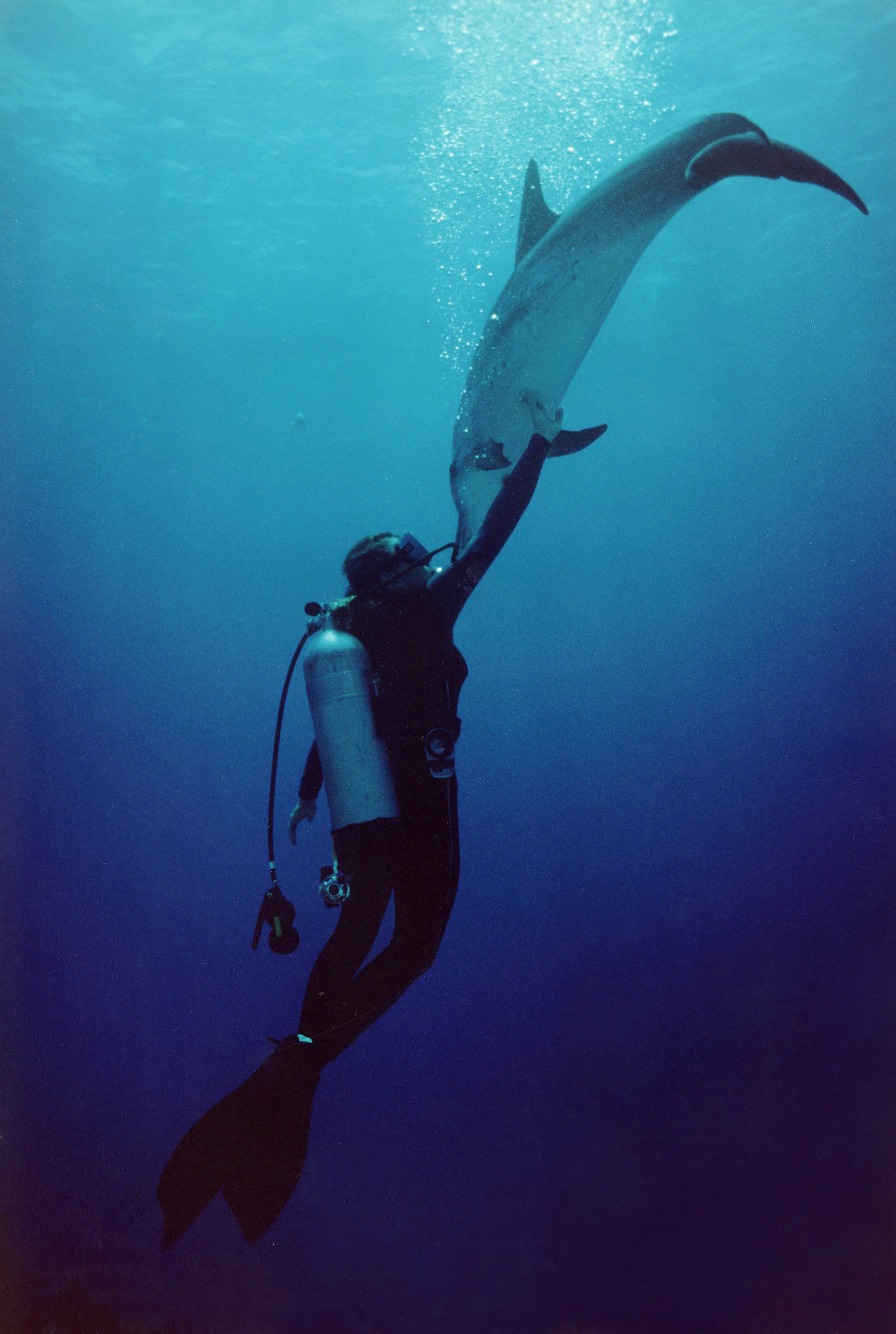
NARRATOR: “We call it the blue planet, yet the creatures we know best rule the land. But one of nature’s most impressive creatures is an ocean dweller often missed and seldom understood... Swifter than a dolphin... A hunter as bold as the Great White shark... The Blue fin tuna is perfection made real. Designed for speed, it races the currents at 50 miles an hour—one of the fastest swimmers in the sea. A warm-blooded giant, it crosses whole oceans at will spanning the seas on epic journeys.”
DR SYLVIA EARLE: “The ultimate fish has to be the Blue fin tuna. Those creatures that can power their way across the whole ocean basin. That has to be the supreme creature unlike any other on earth.”
NARRATOR: “But the Blue fin tuna is hunted whereever it goes. And there is a serious debate about the consequences.”
SCIENTIST: “I sincerely believe the Blue fin tuna is now in a state of crisis. All our people should know that what we did to the buffalos on land, we are doing to big wild animals in the ocean.”
NARRATOR: “On the front line of the controversy is a small group of scientists struggling to learn the secrets of the Blue fin as quickly as they can. For them, there is even more at stake than the legendary animal itself.”
DR SYLVIA EARLE: “If the ocean is in trouble, our future is in trouble. These creatures are the lions, the tigers, the wolves, the eagles of the ocean.”
NARRATOR: “It is a creature so advanced, its deepest secrets may always ellude us.” (end of clip)
Well, there you go. It’s the Blue fin tuna—a fish that many people love. It is so rare to see them other than as sushi or sashimi. The taste for tuna in the last half century has grown to a state right now where their numbers have significantly declined.
Imagine that within less than 50 years, we managed to whittle down their numbers from what they were when some of us were kids to a fraction of their former numbers. It is because our taste for them is at a point where our technology has reached a level where we can find and bring to market every last one, should we choose to do so. It seems preposterous.
When I was a child, and even now, many believed that the ocean was infinite in its capacity to yield back to us whatever we wanted to take out and to absorb whatever we wanted to put in. And perhaps the greatest discovery about the ocean in the last century has been first of all that the ocean really is at the heart of what makes the planet work—the cornerstone of our life support system. But the second big discovery is that we do have the capacity to alter the way it works, to really diminish creatures that once seemed to be infinite in their capacity to rebound no matter how many we extracted.
It’s a hard thing for most people to face up to especially when our numbers are growing and prospering at such a rate. Population on our planet has tripled in my lifetime, that is, human population. While all other species, our fellow creatures, are diminishing in their numbers. Not all creatures, but certainly some of them that we have particularly targeted for taking.
So, what do we do about it? The first step is knowing. If you understand that there is a problem, there is a chance that you might care, and if you care, you might do something about it. If you don’t know, you can’t care. And that is the idea that the ocean is not infinitely preserved; that we do have the capacity to change the way the ocean works. And that it does matter to us, it comes back to us. It doesn’t just matter to the fish and the whales and the turtles and the sharks. It matters to us, because we, too, are connected to all that blue stuff out there that governs the way the ocean works.
I want to give you one other example. I know that both in this conference and over the years that this conference has been carried out, the focal point has been the fate of sharks. Oh, I certainly remember as a kid, the feeling was that really the only good shark was a dead shark. And a lot of people thought they were really doing a great thing if they would exterminate every shark that they could find. And the problem was, you know, that people thought that sharks were man-eaters—of course, I didn’t worry about that, because of my gender, I didn’t qualify. But now, the problem is, man eating sharks.
You know, lots of them, millions of sharks, are munched on by us. And every once in a while, they turn around and take a bite out of one of us. But maybe they are allowed when you take a look at what we are doing to them.
Let me just give you this little example from an island that people rarely go to. It’s off the coast of South America. It’s part of the eastern tropical Pacific seascape—that body of water that sweeps along the coast of Equador, Panama and Costa Rica. It’s a small group of islands, a kind of a halo of islands, where until recently, sharks were really, really common. You could count on finding scorpions and hammerheads and other species of sharks... white tips in abundance. However, in just a year, that has changed.
Can we save the ocean? It is hard to tell. To keep the options open, to help the creatures such as those in the South Pacific in 2003, you have help to keep doing your part. The birds in the sky, the fish in the sea, the predators of the ocean—the sharks, the tuna—all of those creatures have a role to play. So do we, of course. But we are supposed to have the brains to be able to figure out how to find a place for ourselves within these natural systems upon which we are living with them. But as of right now, it is clear that we don’t get the picture... that we are over-using the life support system that we need to maintain ourselves.
The key though is to do exactly what you are doing—an unique solution— the efforts that you are making to reverse this plan. I figure that the next ten years may be the most important decade in the next thousand years. Based on two things: as never before, we know what’s going on and we understand the importance of the natural world, particularly, the ocean to us. But maybe there’s never been on the one hand a chance as good as the one we have right now.
You can say, “Well, 90 per cent are gone of the sharks, the tuna, the swordfish,” and climb down the long list of depressing numbers of creatures that have real trouble, or you can say, “Hey, 10 per cent of those numbers are still out there. They’re not all gone. There’s still a chance.” It’s that attitude, that optomistic spirit that I see throughout this conference.
You know, we can do something. We don’t just have to sit around and moan and groan. We have the power to make a difference. We can support those who are taking actions, people such as those in government seeking protection of species in the sea.
I got really excited some years ago about the concept that we can do for the ocean what’s been done with the land in terms of protecting areas of national parks. Around the world, some 12% of the land has been embraced by humankind for protection as parks, preserves and wildlife areas.
It’s not perfect. It’s not enough. But coupled with supporting policies that care about originates, about watersheds, about what we put into rivers, lakes and streams, and certainly, the ocean, we can, however, stabilize the downhill trends, and in due course, if we are really smart, we’ll see a change, a turnaround.
And find that place where we can actually look forward to an enduring future.
So, when National Geographic a few years ago, asked if I would be interested in coming to Washington D.C. to be an Explorer-In-Residence, my first thought was, “Well, that’s great... Explorer-In-Residence... kind of a contradiction in terms.” But the idea of doing something with National Geographic was something I liked to do. The deal was that for six months they would support you with a supplement for something you would really like to do.
But about the same time, I had another opportunity to work with a foundation, which is based in San Francisco, California, on a project for about five years. And they wanted to do it on conservation, on education, on research about the oceans.
So, while putting the two things together, this five-year mission of exploration, research and education, conservation and creation of the Sustainable Seas Exhibitions, another more fortuitous thing happened.
And that was that Dr Phil Nuytten, from whom we will hear very shortly, came up with a brilliant concept for a new kind of submersible—one that was so simple, even scientists could drive these submarines around—taking you down to 2000 feet (667m), which covers a fair part of the Continental Shelf therein parts of the United States and continental waters of many countries, actually.
And so the idea of putting this thing together with the resources of the National Geographic Foundation in San Francisco and working with the agency where I served as chief scientist, as a program, we put together this project.
The project grew from six months to five years—I am working on being explorer-in-perpetuity right now with National Geographic—continuing beyond the coastal waters of the United States and moving to the waters of the world. Moving to your backyard, to this part of the world, towards the area where the highest concentration of many species in the ocean is about to occur—in the famous coral triangle, this part of the planet where fish and other invertebrates and plants all seem to have a special atypical circumstance. But we know very little about what this world except where divers can go.
But now with new technologies now in the circle, we don’t have to look wistfully over the edge at these steep drop-offs or sit at the side of a boat or the shore and just wonder. We can actually go.
There are luckily now, in the United States, some 18 thousand square miles of ocean that have been embraced as protected areas, as marine sanctuaries, although it’s mostly in name. A very tiny fraction of that small amount of the waters of the United States have full protection in the way that a national park does.
And around the world, although there are more than 3000 places in the ocean being investigated for some form of protection, it’s a tiny fraction of that amount that has real protection in a similar way that we think of in a park where in you don’t cut down the trees or trap the wildlife or catch the fish.
We use the ocean in mutliple ways including recreation, diving, and all the rest, but many of the ways we use the ocean are consumptively destructive. If we are to have fish in the sea in the future, for whatever reason, to take them out of the sea, we have to do what we have in some ways already done to creatures on the land: protect the breeding areas and the feeding areas. Otherwise, we might breach migration routes, and so on.
In fact, a fraction of one percent of the ocean has any known protection as compared to the land where about 12% has fairly extensive protection.
It was about 100 years ago that people began to get serious about protecting wildlife on the land and protecting habitats where they lived. If people wanted to have ducks and other birds to consume, they had to protect the breeding areas, the feeding areas, the boundaries. Now we need to simply apply these measures for the sea... for tuna, for swordfish, for sharks for heaven’s sakes... for anything that is out there, we must, at this stage, seize the opportunity that we have now, but won’t have much longer.
You know, all we have is right now. I met a psychic that said that we have a chance like no generation before us to make a positive difference just as our predecessors did years ago when the idea of protecting wildlife on land came with a purpose. Now, it’s our turn with the ocean—this time, our time, to make decisions that will resolve the balance through years to come.
Eighteen thousand square miles of US water sounds like alot, but the Great Barrier Reef in Australia is 144 square miles of ocean. And even then, despite that vast area has enjoyed such protection since the mid 1970’s, there are some real problems. It’s more of a management area than it is a fully protected area.
Good news: a lot of things are better off than they would have been have they been without any protection at all. But just last year, it was at a point where measures had to be taken to really do something more. So, full protection was increased from about 6% to 33%, a good third of that vast system now has been given better protection.
And in the United States, places that we have had a chance to go to during the Sustainable Seas series of expeditions is now under consideration to become an even larger body of water under protection—the northwestern Hawaiian Islands.
But again, when we think about the ocean as a whole—how much there is, how much there is to do—these are baby steps, and we want some giant steps.
So, I first, salute you for all that you are doing, and I challenge you, that when we get together, and I will come back in years ahead, we should be mindful of what progress we can make as individuals, as organizations, whatever it is, whatever talents you have... I get asked a lot, “I am just one person. What can I do?”
First thing you do is pick up the mirror and look at it and say, “I take great underwater photographs.” Use that talent. Or you can say, “I can play wonderful music.” Use that talent. If you are good in math, or you can draw or you have a way with words—whatever it is, use it, so that you can look the next generation in the eye, and you can look yourself in the eye, and be confident that you have done what you can to make a difference. Thank you.
For more information about Dr Sylvia Earle and her organization, Deep Ocean Exploration and Research, visit: www.doer-inc.com ■
Published in
-
X-Ray Mag #6
- Read more about X-Ray Mag #6
- Log in to post comments

